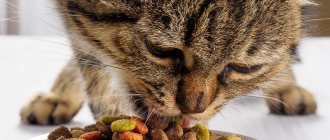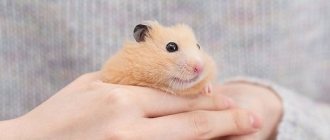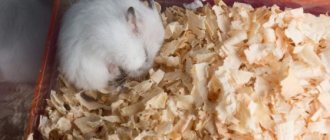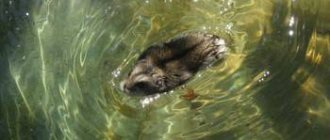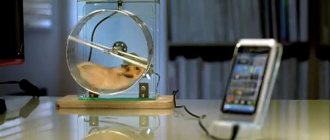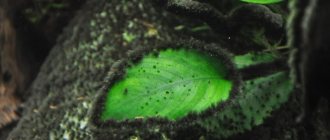Why do you need a ball at all?
Many rodent owners, when they first heard about a walking ball for a hamster, are perplexed - why is this thing needed? But having tried the attraction in practice, they are convinced that this little thing is very necessary. It will be useful not only for the hamster, but also for the owners themselves.
Walking balls for hamsters are needed because:
- help release excess energy more effectively than a running wheel;
- help maintain the shape of the fluffy, prevent him from getting fat;
- a hamster in a ball can explore the apartment;
- after an evening walk in a ball, the hamster is so tired that it does not make noise at night and does not disturb the sleep of its owners;
- when the hamster is in the ball, you don’t have to be afraid that he will run away and hide;
- You can put the homa in the attraction while cleaning the cage.
Many people claim that the hamster can be allowed to walk inside the ball, even if there are other pets at home. If you don't care about your furbaby's mental health, then you can do so. Most hamsters will feel unsafe around a cat, regardless of which side of the ball they are on. Therefore, during your walk, keep your furry baby calm: remove other animals!
Criterias of choice
Like any other device, the walking sphere has specific criteria for the correct choice, since its ability to fully satisfy all the needs of the rodent depends on this. In most cases, hamster owners manage to purchase the right ball without special knowledge.
But in order to protect your pet from possible injury, you need to know several important rules for choosing this sports accessory.
Main size
Choosing the optimal size is the main condition for purchasing a ball that is safe for the health of your hamster.
Balls for rodents are divided into several types:
- 12-13 cm;
- 18-20 cm;
- 28-33 cm.
The smallest of them, with a diameter of no more than 13 cm, are suitable for small rodents, which include Djungarian, Sungur hamsters, Campbell's hamster, Roborovsky's hamster and similar varieties.
For larger species, such as the Syrian hamster, a medium-sized sphere (18-20 cm in diameter) would be an ideal option, but for large rodents (common hamster, etc.) the largest possible sphere with a diameter of 28 cm or more is best. cm.
The area for walking should be chosen strictly according to the size of the animal. The angle of the animal’s back depends on the size of the walking device, which is the main condition for its safe operation.
In a ball of the correct size, it should be almost even. If you choose an excessively small sphere, then due to lack of free space the animal's back will be strongly concave inward.
It will also be useful for you to learn how to choose a cage for a hamster, what hamsters eat, how long hamsters live at home, and how to train a hamster to respond to its name.
A single walk in this position will not harm your pet, but regular stress can lead to problems with the spine. But you shouldn’t go to extremes, since a large ball will also negatively affect the movement of the rodent.
In this case, his body will throw from side to side when moving, and this will only worsen the quality of the walk and can lead to damage to the baby’s delicate paws.
Important! The diameter of an ideal walking sphere should be several centimeters larger than the length of the pet’s body.
Is color important?
In most cases, hamsters use their sense of smell when moving. In these animals, the organs of vision are not as developed as in humans, so their eyes can only distinguish the outlines of objects. The same applies to color perception.
Hamsters have difficulty distinguishing primary colors, and they practically cannot distinguish shades of red at all. The only exceptions are yellow and green; rodents distinguish these shades very well, which helps them find the necessary food (especially in the dark).
The ideal color scheme for a hamster would be a transparent, colorless walking ball. It will provide the necessary overview, as well as access to a sufficient amount of light. But if you couldn’t find it in your pet store, pay attention to devices made of plastic with a green or yellow tint.
The amount of light transmitted by them will be slightly lower, but these shades will help the animal increase the contrast of surrounding obstacles.
Do you need fastening?
As mentioned above, the mount for the walking ball is an additional accessory; its task is to secure the device in one plane.
In this case, the hamster will not be able to move freely around the apartment or room, but such a device still provides the necessary exercise stress.
For the most part, additional fastenings are useless, since each rodent cage is equipped with a sports wheel that operates on the same principle.
Did you know? Hamsters are one of the few mammals that are born with teeth, and their growth increases throughout their lives.
However, sometimes it is necessary. Daily walks often bring a lot of discomfort, especially when guests arrive, since the animal can be accidentally injured by a person.
In addition, many hamsters are not always willing to move in a wheel, which cannot be said about a walking ball. Therefore, if your pet has chosen exclusively the sphere, then you cannot do without a fixing mount for it.
How to choose a toy?
In order not to make a mistake in choosing a simulator, you need to know what balls for hamsters are and what types they come in. Typically this type of toy has a round shape, but elliptical models are also found. A round walking ball is much safer for a hamster than an oval one, because it does not swing from side to side.
The simulator can be sold without everything or in a set with various stands. A very stable base is the square leg. There is also a stand in the shape of a globe, which looks very original. The hamster ball on the stand is designed for walking in place, that is, it is a modification of the wheel. But at any time you can remove the toy from the support, put it on the floor and send the home for a walk.
When choosing a simulator, there are several points that you need to pay special attention to:
- Size. The main rule: the hamster should not be cramped in the toy. The optimal diameter for the dwarf and Roborovsky's hamster is 12 cm, while the Syrian needs a spacious attraction - from 18 cm.
- Transparency. In general, a walking ball for a hamster can be any color you like. But at the same time, it should be as transparent as possible so that the pet does not bump into furniture while walking. A collision can cause the toy to break and the animal to run away. The best option is a colorless transparent ball.
- Number of ventilation slots. Physical activity speeds up your pet’s breathing, therefore, oxygen is consumed more actively and carbon dioxide is released faster. To prevent this funny animal from experiencing choking attacks, choose a ball that has holes all over its surface.
- Reliability of fastenings. Walking balls for hamsters can have from 1 to 4 entrance holes, which are closed with special lids. Check if they are screwed securely. If the fastening is loose, there is a high probability that the nimble animal will run away.
- Material safety. The store must have evidence that the plastic is non-toxic. Be sure to ask for a certificate that confirms this.
Whether to buy a ball on a stand is up to you. But in this form it is very convenient to store the toy; it will not roll or get lost.
Description and purpose
Small rodents, including hamsters, are active animals. In the wild, in search of food, they are able to cover about 10 km per day, which is their natural need, as well as a necessity for body tone.
But in everyday life, not many of us have the resources to provide the rodent with such conditions for freely spending excess energy. Therefore, leading scientists have created a sufficient number of various sports accessories for hamsters.
Did you know? Hamsters were discovered by English naturalists Alexander and Patrick Russell in the middle of the 18th century near the city of Aleppo
(Syria).
The most effective among them is the walking ball (walking sphere). It is a transparent plastic sphere consisting of 2 halves, as well as a small door for the rodent.
To ensure the necessary comfort, the ball is equipped with several ventilation holes to allow oxygen to enter inside. Through the door, the rodent gets inside the sphere, after which the active running of the animal sets it into motion.
This device allows the baby to move freely around the room or apartment. This allows him to maintain the necessary activity, as well as periodically change the environment, which is important for the psychological state of the rodent.
Today there are many models of such a device, but they are all divided into simple and with a trajectory of movement.
The simple ones are an ordinary smooth plastic ball; the more advanced ones have special restrictive grooves that help the animal more clearly adhere to the intended trajectory of movement.
Which breed of domestic hamster to choose: Syrian hamster, Djungarian hamster, steppe hamster.
Often the ball comes with special stands that secure it in a certain position, in which case it functions like a sports wheel.
The walking area has many advantages for both the animal and its owner, let’s consider them in more detail:
- the ball allows the rodent to keep itself in the necessary sports shape and, unlike a simple wheel, contributes to the maximum load on the body;
- allows the hamster to safely walk around the apartment;
- helps to increase the living space of the hamster;
- The ball has a low cost and is also easy to care for and use.
Did you know? Hamsters are able to carry a mass of food in their cheek pouches, which is equal to about 20% of their own weight.
Model overview
If you are not sure which hamster walking ball is suitable for your pet, study the assortment in the store and consult with the seller. There are many good balls for walking hamsters, the price range is quite wide.
Here are some of the most popular models:
- Fun Bowl. Oval ball for Syrian hamsters. Larger diameter – 19 cm. Colorless transparent plastic. The trainer has 4 doors and 20 narrow ventilation slots. Cost 760 rubles.
- Super Pet. Round balls of various colors. They have 2 entrances and many holes for air circulation. The product is certified, non-toxic. The company produces balls for hamsters of different sizes. Thus, a toy for a Dzungarian (d = 12.7 cm) costs from 300 rubles, and for a Syrian (d = 18 cm) – from 490 rubles.
- Trixie. The round hamster ball is sold with a stand. A stable base in the form of a square. The toy is intended for Syrian hamsters (d = 18 cm). The body is transparent, colorless. Has 2 doors. The cost of the set including the stand is from 380 rubles.
- Credo. A ball made of transparent orange plastic for dwarf hamsters (d = 12.5 cm). There is only 1 exit, but the ventilation windows are evenly spaced. One of the cheapest models, costs about 200 rubles.
- Savic for dzungarians and Roborovsky hamsters (d = 12 cm). 2 entrances, round and slot-shaped ventilation holes. Price – 330 rubles.
- Georplast for small breed hamsters (d = 12.5 cm). A very stylish toy, made in the shape of a globe. The stand is stable. There are 2 entrances to the ball, ventilation is excellent. Cost – from 420 rubles.
A correctly selected ball will help the animal explore the world and keep itself in good shape. But for this, the khoma needs to be taught how to use the simulator.
Hamster ball from a plastic bottle
One of the best options is a plastic bottle. It is quite light, which means your pet will not have problems moving around in it. In addition, ventilation holes can be made in it without any problems.
In order to build a walking accessory for your pet, you will need a small plastic bottle. For example, you can use a transparent milk bottle: it is small in size and quite light. Another plus is the thick neck. This way, your pet can easily climb into it and go for a walk.
Next, you need to cut holes in the bottle for ventilation. Now you can let your pet inside, close the lid and let him run around to his heart's content.
The advantages of such accessories are as follows:
- the toy is easy to make and use;
- light weight will allow your pet to move easily inside it;
- There are no financial costs at all.
Teaching a hamster to ride
You bought your home a new exercise machine, but this does not mean that he will immediately understand what to do with it. You will have to spend several days training your pet to use this toy. To make the process go smoothly, remember a few tips:
- choose a time when the fluffy has slept, had dinner and is ready to play;
- put the toy in the cage, opening all the entrances, and let the animal get to know it;
- when the homa goes inside, close the lids (they must be inserted into the entry holes and turned clockwise);
- check whether the doors are closed: it is better to double-check a couple of times than to later catch a tiny creature throughout the apartment;
- now take out the ball along with the animal and place it on the floor;
- when the rodent gets used to it, it will begin to move its paws, and the ball will roll;
- The first lesson should not exceed 5 minutes; you need to put the simulator back in the cage and open the doors.
Classes in the first week should not last longer than 5-10 minutes. When the fluffy gets used to the new toy, the walking time can be increased to 20 minutes a day, but it should not be more than half an hour. After all, excessive physical stress is very harmful for tiny creatures.
When walking, remove dogs and cats from the room. Even if your other animals are quite peaceful towards rodents, they can still scare a cute animal with their sight and smell. Do not leave the homa in the ball alone for a long time. What if at exactly this moment the door of the toy breaks and the rodent escapes?
After completing the walk, the toy must be washed and dried. The floor in the room where the animal was rolling around will have to be swept or washed, because during the walk the pet could have lost reserves from its cheek pouches, peed itself, or had a bowel movement.
As practice shows, after purchasing a walking ball for a hamster, the animal begins to behave calmer at night, as it loses a lot of energy during “excursions.” Don’t forget to pamper your furry pet after such walks with a piece of his favorite treat, especially during training.
Features of use
Despite the fact that this rodent walking device is quite easy to use, many hamster owners make serious mistakes in using it.
This can end badly for the health of the hamster and the emotional state of its owner. Therefore, next we will consider the basic principles of its safe use.
As a pet rodent, you can also choose a jerboa, guinea pig, ornamental rat, gerbil, dormouse, squirrel, chipmunk, degu.
How to use a walking ball correctly
The first thing you should do after purchasing a walking sphere is to gradually accustom your pet to it. Most rodents are quite timid animals, so having a hamster in a new space can be quite stressful for him.
Walks should begin gradually; first, the rodent must be introduced to the ball; for this, the animal must be placed in it for several minutes.
Every day the time the hamster stays in the ball should be increased, until it is completely mastered in new conditions. To interest the rodent before each walk, you can place a small piece of fruit or vegetable inside the device.
In the first days, you should help the hamster master the basic principles of movement in the sphere. To do this, the ball must be gently pushed or rolled from side to side. In most cases, the rodent fully understands the new entertainment within a few days.
Important! If the hamster does not show sufficient interest in free walks, it should not be forced, as this will cause additional stress in the animal.
When the animal is completely comfortable, you can begin daily walks.
Walking can be done in several ways:
- free;
- on a certain perimeter;
- along specially constructed tracks.
The safest are walks along a given route; for these purposes, special routes with low sides, closed in a ring, are created. However, not everyone can afford such an accessory.
Such routes require the availability of a sufficient amount of free space, as well as the expenditure of additional funds on their arrangement.
Most often, hamsters are walked in a certain area. To do this, they are released into an empty room or simple barriers are built. Free walking is less preferable, due to possible injuries (both to the rodent and its owners).
Suddenly the hamster may roll out from around the corner at the feet of the owner or the rest of the family, in which case injury to the animal cannot be avoided. The duration of daily walks is individual for each individual, but in most cases, hamsters are walked no more than 30-60 minutes a day.
Precautionary measures
Basic safety measures when walking a hamster in an outdoor area:
- the door of the device must be tightly closed, otherwise the rodent may escape;
- Walking should be carried out on a flat and uniform surface, away from stairs and other changes in height;
- walking on a table, windowsill, etc. without a special stand is strictly prohibited;
- if there is a cat, dog or other large animal in the apartment, they must be taken to a separate room;
- the hamster must move independently, without external assistance, otherwise this can lead to serious injuries to the animal;
- only one animal can walk in one sphere;
- It is not recommended to place any objects inside the sphere;
- it is strictly forbidden to wrap the walking ball in polyethylene or cover the ventilation holes, otherwise the rodent may develop hypoxia;
- After each walk, the sphere should be washed with detergents and dried.
Important! All family members should know about the hamster's walk, especially if there are small children among the household members.
Advantages and disadvantages of a homemade exercise machine
Store-bought toys for rodents are quite expensive. You can purchase a high-quality attraction for 400-800 rubles, but this does not guarantee that the ball will last long. Over time, the fastenings that lock the hamster inside the simulator become loose. As a result, the toy becomes unusable and the hamster can easily escape. Buying several balls a year is very expensive, so it’s better to make a ball for your hamster yourself.
Of course, it will not be quite a ball, that is, not a sphere. But for convenience, we will still leave the concept of “ball”. On most homemade simulators you can move forward and backward, but you cannot move left and right. This is the disadvantage of a homemade ball. It will also be difficult to clean from the inside. But let's look at the advantages, because there are many of them:
- Cheapness. You don't have to spend money to create a walking ball.
- Availability. Pet stores are located at every step only in large cities. In small settlements they may not exist at all. And to make a ball for a hamster with your own hands, you don’t need to go anywhere, you have everything you need at home.
- Quality of fastenings. If the fastenings of store-bought simulators quickly become loose, this will not happen with a homemade toy. After all, you will be making it from a bottle with a screw cap, the main thing here is not to break the thread.
- Easy to replace. If a Homa has chewed a walking toy, or it has become very dirty from the inside, you won’t mind throwing it out and replacing it with a new one.
- Simplicity. It is very easy to make a ball for a hamster; you will need a minimum of materials and tools. And you will spend no more than 5 minutes on the craft.
As you can see, the advantages of a homemade toy clearly outweigh the disadvantages.
pros
Purchasing this accessory has a number of obvious advantages. Since you have a pet, you will need to provide him with sufficient physical activity or at least not disturb the animal. Any hamster owner will tell you that these rodents are very active: every day they can spend hours circling the cage or running in a wheel. Rodents by nature need somewhere to spend their energy. This fact determines their behavior. Of course, a running wheel will cope with the task, but in a walking ball the hamster will be able to spend time not only usefully, but also with interest. The pet will explore the territory of the apartment or house without dirtying anything and without the risk of being eaten or injured. In addition, at the end of the walk, the owner will not need to crawl under the sofa in search of his friend.
Making a walking ball
Any child can figure out how to make a hamster ball with their own hands. The ideal material for this toy is lightweight plastic. Here are some ideas.
Walking ball from an old lampshade
An old round plastic lamp is very suitable for creating a toy for a pet. The plastic should be transparent so that the animal can see where it is going. Typically, such lampshades have a diameter of 13-15 cm, so balls from them can be made for both Djungarians and young Syrians.
First you need to make preparations. Take a lampshade and a scrap piece of plastic to make a door. Cut a circle that matches the diameter of the hole in the lampshade.
Now drill holes in the door and in the ball so that air can flow inside during the walk. It will be difficult to make a special mount for the door, but you can glue it to the ceiling with tape for the duration of the hamster walks.
The obvious advantage of such a toy is its shape, because the hamster can go in the direction he wants. The downside is that the mount is not very reliable. If the lampshade is made of thick plastic, it will be difficult to make ventilation holes, because you need a lot of them.
Bottle toy
Another option for making a simulator from scrap materials. You can make a bottle toy for your dwarf. Liter Prostokvashino milk containers are perfect because they are transparent and have a fairly wide neck. But if you are Syrian, you will need a larger bottle, you can even take a 5-liter one.
So, here is the algorithm for creating a toy:
- Rinse the container thoroughly and dry it;
- If the label goes all the way around, remove it so that in the future it will not block your home's view. On 5-liter bottles the label can be left;
- Make cuts all over the surface. They should be long and narrow (0.3 x 4 cm). The more ventilation slots you make, the better air will flow to your pet;
- check that the thread on the cover is intact.
That's all, the simulator is ready for use. Place your furry treasure in it and go for a walk!
Glass jar exercise machine
Glass is not a very good material for making hamster rides. But if you don’t have any plastic bottles on hand, try making a walking ball from a glass jar.
A glass jar, rolling on the floor, will knock loudly; your furry will not like this sound. To muffle the sounds, the jar must be covered with a ribbon with imitation lace: this way the sound will not be so rumbling, and visibility will be partially preserved.
Be sure to make a lot of large holes on the lid, because you won’t be able to drill them in the jar itself. Now you can give your hamster a ride. But remember: due to the low breathability of the can, the maximum duration of a walk is 10 minutes.
Attention! Don't be too careful about closing the lid or you won't be able to get the hamster out!
Disadvantages of purchased hamster wheels
There are a wide variety of walking balls for hamsters on sale. They can be of any colors and sizes. It is necessary to select a walking ball in accordance with the size of the hamster. For dzhungariks, its diameter should not be too large, otherwise he simply will not have enough strength to move it. For Syrians, too small a space inside will not allow them to move their paws freely. In both the first and second cases, the hamsters will quickly get tired. If you decide to make a walking ball with your own hands, then you need to take into account all the disadvantages by building the optimal and safe accessory for your pet.
In purchased walking balls, the fastening of the lid weakens over time, and the lower the quality of the product, the more often you need to monitor this. After all, if a hamster falls out of the sphere while walking, it risks falling into the paws of a cat or dog, and household members may also step on it.
Like any product, a walking ball costs money. The price depends on the quality of the material and size. On average, the cost varies from 300 to 2 thousand rubles. You can save money if you make it yourself from scrap materials. This craft will not take much time and will diversify your leisure time.
Operation of the walking ball
In order for an animal to love rolling in a ball, it must first get acquainted with a new toy. Place the walking ball near the hamster and let the animal sniff it. Put something tasty inside and put your hamster in it. Do not immediately close the lid, such an act may frighten the tiny creature!
Let the home sit in the bottle and get comfortable. When he gets used to it a little, screw on the lid and place the walking ball on the floor. Make sure that there is no dog or cat nearby, they can greatly scare the hamster. There should be no stairs on the way from which the walking ball could fall. Such a fall can result in serious fractures, a heart attack, or even the death of your furry friend.
You also need to keep an eye on the walking time. Excessive physical activity has never benefited anyone, especially tiny animals. The maximum time spent in a plastic ball is half an hour, and if the simulator is made of glass, then 10 minutes.
A self-made walking ball is not as comfortable as purchased models. But its production will not cost you anything and will not take much time. This toy is quite practical, and it can also be easily replaced with a new one.
Hamster ball: which ones are on sale?
You can find several types of walking balls in pet stores. How to make the right choice? To do this, you need to focus on what you expect from the purchase. When choosing, remember that the material from which this accessory is made plays an important role. The stronger the material from which the hamster ball is made, the longer it will last you.
When purchasing, you should also pay attention to the color of the accessory: the more transparent it is, the easier it will be for your pet to navigate in space.
Operating a homemade ball
After production, it is important that the animal accepts its new simulator and is not afraid of it. First you need to arrange an acquaintance with him. Place the ball in the cage with the hamster awake. Place lids, doors and anything else you attached as an inlet to the side. Place your pet's favorite treat in the very center of the ball. As soon as he runs in there, do not rush to close the doors, as this may greatly frighten him. All movements must be smooth.
Give your hamster some time to get used to the new ball. Contact with other animals is excluded during this process, as your pet may experience severe stress.
The hamster will be equally comfortable in both a purchased and homemade ball.
When letting him out for a walk, make sure he runs on flat surfaces. Stairs are contraindicated; your furry friend may fall. As a result, you can break your bones, have a heart attack, or even die.
Keep track of how much your pet walks. The time for large breed rodents can be slightly increased. If the simulator is made of plastic, then release it for a maximum of 30 minutes, if made of glass - for 10.
The hamster will like a homemade ball just as much as a purchased one. This is a fairly practical and cheap option that will give your furry creature a lot of joy and enthusiasm for new victories.
First steps
Accustom your pet to the toy gradually. To interest the animal, put a treat inside. When he comes in, close the door and twist the sphere a little. If the hamster understands what is required of him, let him choose the direction and speed of the ball.
The first trips should be short - five minutes is enough. Gradually increasing the duration of the walk, bring it to a maximum of half an hour. Staying in the ball for a long time is dangerous: the pet can die from overheating, lack of oxygen, or thirst.
If your hamster resists walks, don't force it. Persistence can result in stress for the animal. Some individuals begin to panic when they find themselves in a confined space. Perhaps Fluffy doesn't like this particular ball. Try offering him another one.
Pros and cons of purchased balloons
Advantages of a purchased ball
The advantages of buying a ball are obvious, as they make caring for your rodent much easier. Moreover, such a purchase is relevant for hamsters, since they are physically active animals. In just one day, a hamster is able to make hundreds of circles while in such an attraction. It is also important to say that the hamster needs this kind of stress, as this is due to its nature. An ordinary running wheel does a good job of this, but a walking ball for hamsters can significantly expand the horizons of a rodent and give it the opportunity to leave the territory of a cage or aquarium without worrying about its safety. It is worth noting that running in a ball is not as simple as running in a wheel; here the hamster will have to try hard to get to the place of interest.
Disadvantages of the finished design
Speaking of disadvantages, it is worth saying that the disadvantages of a walking ball are often due to flaws in its design. For example, there are some models in which the manufacturer does not take into account the ventilation holes; such balls are usually not recommended for purchase. In addition to the fact that through them the animal will have access to oxygen, with the help of these holes all natural excrement can be freely discharged outside. By the way, this is one of the reasons why a hamster should not be left in a ball for a long time, because no one has yet canceled the natural need. If a slight embarrassment occurs, then you will no longer have to clean the cage, but the entire area that was used during the ball rolling.
It should be noted that over time, the fasteners in the ball may wear out. Thus, the risk increases that the ball's lid may open involuntarily while the hamster makes another turn. To prevent the animal from being injured, check each time before use how securely the ball is closed.
Price
Depending on certain parameters, the price of such toys may vary. The cost is greatly influenced by the manufacturer's brand, pet store, region of residence and equipment - many are sold together with stands.
On average, a hamster ball costs from 100 to 500 rubles. You can choose any model that is suitable for the rodent and will suit the owner at a price.
How to do it yourself?
A walking ball for a hamster is inexpensive; you can buy a toy for 100 rubles and more. But some rodent owners prefer to give them a gift with their own hands, so they put a piece of their love and energy into the sphere. Such products also have pitfalls. Before conducting a master class on creating a homemade sphere, we will consider the advantages and disadvantages of a home-made simulator.
The biggest drawback is that it is not always possible to create an ideal sphere; the product takes on an oval shape rather than a round one. This means that the hamster will run forward and backward, but will not be able to move sideways. In addition, homemade products are difficult to wash from the inside.
As for the positive aspects, there are many more of them.
- A gift for a hamster will be free, as it is made from improvised materials.
- Not every locality has a pet store where you can purchase a walking ball. And in order to make it yourself, you can find material in every home.
- The homemade simulator is secured, most often, using a screw cap - this is much more reliable than industrial devices.
- Making a toy is simple and quick. If it loses its attractive appearance, it’s not a shame to throw it away and it’s easy to make a new one.

